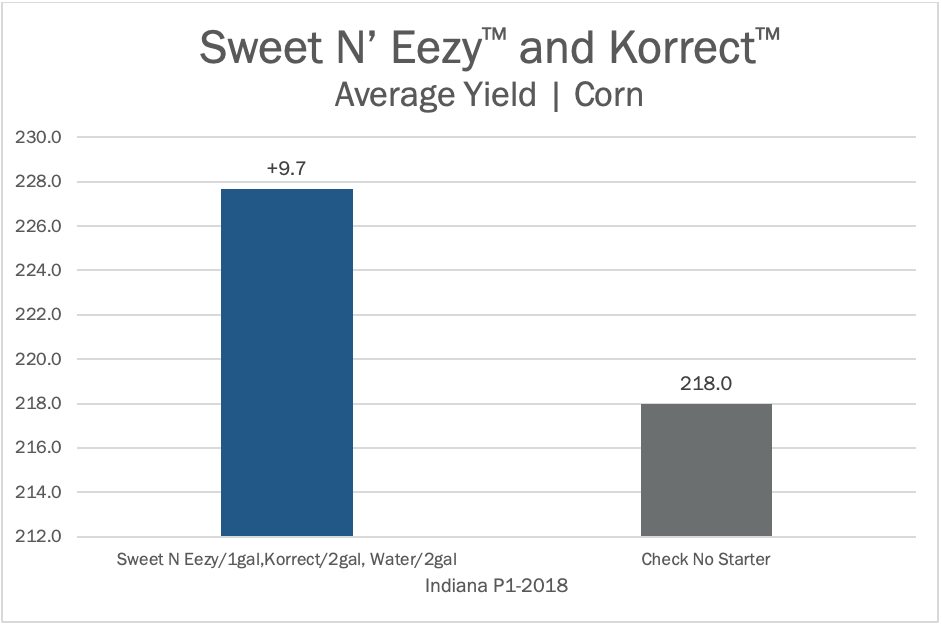Update From The Field: Three Objectives for Using Starter Fertilizer
Posted by Dave Dyson, Agronomist on May 22, 2019
The post may reference products and/or services only available to our Retail Farm Center customers. For more information contact your Territory Manager at The Andersons.

As the rain continues and planting dates keep moving back, a very important question on the table is, “Should I take the time to apply a starter fertilizer when I plant?” The answer is a resounding, “YES!” The soils and young seedlings are caught in the triple threat consisting of:
1. Compacted soils from mudding harvest last fall and planting in mud this spring
2. Cool soils that have been extremely slow to warm-up this year, and
3. Wet soil conditions that seem to be persistent throughout the Corn Belt
This triple threat is resulting in less nutrient uptake due to slow and restricted root growth. Starter fertilizers help mitigate slower growth rates attributed to decreased mineralization in soil and lack of nutrient mobility that is common in cool, wet and compacted soils.
There are three main objectives for recommending a starter fertilizer to you:
1. Faster emergence
2. Quicker growth processes leading to earlier pollination
3. Earlier crop maturity and dry down
If the corn plant can achieve all three objectives, the chances are better than 80% that you will obtain higher yields, according to research conducted between the years 2013-2018 in a variety of geographies (Figure 1).

Figure 1: The above graph is a compilation of trials involving PureGrade®Diamond and GoldStart® starter fertilizers compared to a standard fertility program. These trials were conducted in the years 2013-2018 in Colorado, Indiana, Nebraska, Ohio, South Dakota, and Wisconsin.
There are three main components of a starter fertilizer: nitrogen (N), phosphorous (P), and potassium (K), which are used in large amounts by a corn crop. Nitrogen can be the most limiting element in corn production. By applying nitrogen as part of a starter fertilizer program, you can split up nitrogen applications, which increases the efficiency of N utilization while decreasing the potential for leaching and denitrification in the soil.
Phosphorus is immobile in the soil with relatively low availability, so corn plants must rely on root growth to take up phosphorus in the soil. If the plant is experiencing restricted root growth due to the triple threat, phosphorus uptake can be reduced. Using a high orthophosphate, low-salt liquid fertilizer will supply a safe and immediately available form of phosphorus to the plant. The Andersons provides this form of phosphorus in our Diamond (100% orthophosphate) and GoldStart (80% orthophosphate/, 20% polyphosphate) starter brands. Placing these fertilizers in-furrow next to the seed will provide available nutrients more efficiently, allowing you to see a “starter effect” at half the rates than a 2x2 application.
Potassium is also involved with early plant growth. Potassium is less talked about than nitrogen and phosphorus, but it plays a critical role in disease management, the transportation of sugars, and root development. The small root systems of a corn seedling cannot reach out and “mine” enough potassium during the early part of its life. Placing Korrect™, a high quality, tissue-safe, potassium acetate product, in-furrow next to the seed provides a K boost that will result in an increased yield response (Figures 2 & 3).

Figure 2: The application of Korrect and Sweet N’ Eezy™ in-furrow increased corn yields 9 bu/ac over the check.

Figure 3: In a trial conducted in Wisconsin in 2018, Korrect was applied with GoldStart 6-24-6. The treatment yielded an 8.6 bu/ac advantage compared to low-salt starter alone. This trial demonstrates that we can increase yield by adding an available form of potassium to the starter.
In conclusion, we need this season’s corn crop to come out of the ground fast and never stop growing. The most efficient way to provide nutrients is placing 3-5 gal/ac of a high orthophosphate, low-salt fertilizer in-furrow. This will allow you to maximize the number of acres you can cover per fill-up, while providing the “starter effect” to the corn. As Dr. Robert L. Nielsen, Professor of Agronomy from Purdue University, states, “Delayed planting by itself is no guarantee of lower absolute grain yield. I see little reason to change any crop input because of delayed planting,” and we agree. Contact your local ag representative from The Andersons for a recommendation of a starter fertilizer.
FOR MORE INFORMATION:
Please complete the form, and we’ll get you in touch with your Territory Manager from The Andersons.

Dave Dyson is a regional agronomist for The Andersons’ Farm Centers which are located throughout Ohio, Michigan, and Indiana. He is an Indiana native and grew up on a dairy farm in Miami County. A graduate of Purdue University with a degree in Crop & Soil Science, Dave has a deep knowledge of various agronomic topics and is committed to helping growers improve their crops. If you have any questions, Dave can be reached at david_dyson@andersonsinc.com.
© 2019 The Andersons, Inc. All rights reserved. PureGrade and GoldStart are registered trademarks of The Andersons, Inc. Korrect and Eezy are trademarks of The Andersons, Inc. All rights reserved.


